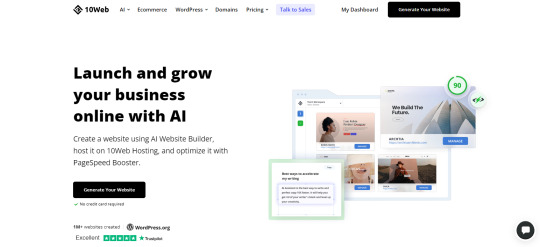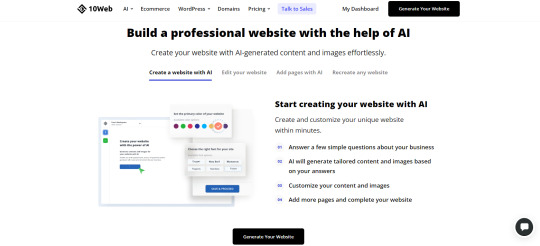#ai builder
Explore tagged Tumblr posts
Text
Dr. Devavrat Shah, Co-Founder & CEO of Ikigai Labs – Interview Series
New Post has been published on https://thedigitalinsider.com/dr-devavrat-shah-co-founder-ceo-of-ikigai-labs-interview-series/
Dr. Devavrat Shah, Co-Founder & CEO of Ikigai Labs – Interview Series
Dr. Devavrat Shah is the Co-founder and CEO of Ikigai Labs and he is a professor and a director of Statistics and Data Science Center at MIT. He co-founded Celect, a predictive analytics platform for retailers, which he sold to Nike. Devavrat holds a Bachelor and PhD in Computer Science from Indian Institute of Technology and Stanford University, respectively.
Ikigai Labs provides an AI-powered platform designed to transform enterprise tabular and time series data into predictive and actionable insights. Utilizing patented Large Graphical Models, the platform enables business users and developers across various industries to enhance their planning and decision-making processes.
Could you share the story behind the founding of Ikigai Labs? What inspired you to transition from academia to entrepreneurship?
I’ve actually been bouncing between the academic and business worlds for a few years now. I co-founded Ikigai Labs with my former student at MIT, Vinayak Ramesh. Previously, I co-founded a company called Celect which helped retailers optimize inventory decisions via AI-based demand forecasting. Celect was acquired by Nike in 2019.
What exactly are Large Graphical Models (LGMs), and how do they differ from the more widely known Large Language Models (LLMs)?
LGMs or Large Graphical Models are probabilistic view of data. They are in sharp contrast to the “Foundation model”-based AI such as LLM.
The Foundation Models assume that they can “learn” all the relevant “patterns” from a very large corpus of data. And therefore, when a new snippet of data is presented, it can be extrapolated based on the relevant part from the corpus of data. LLMs have been very effective for unstructured (text, image) data.
LGMs instead identify the appropriate “functional patterns” from a large “universe” of such patterns given the snippet of data. The LGMs are designed such that they have all relevant “functional patterns” available to them pertinent to structured (tabular, time series) data.
The LGMs are able to learn and provide precise prediction and forecasts using very limited data. For example, they can be utilized to perform highly accurate forecasts of critical, dynamically changing trends or business outcomes.
Could you explain how LGMs are particularly suited for analyzing structured, tabular data, and what advantages they offer over other AI models in this area?
LGMs are designed specifically for modelling structured data (i.e. tabular, time series data). As a result, they deliver better accuracy and more reliable predictions.
In addition, LGMs require less data than LLMs and therefore have lower compute and storage requirements, driving down costs. This also means that organizations can get accurate insights from LGMs even with limited training data.
LGMs also support better data privacy and security. They train only on an enterprise’s own data – with supplementation from select external data sources (such as weather data and social media data) when needed. There is never a risk of sensitive data being shared with a public model.
In what types of business scenarios do LGMs provide the most value? Could you provide some examples of how they have been used to improve forecasting, planning, or decision-making?
LGMs provide value in any scenario where an organization needs to predict a business outcome or anticipate trends to guide their strategy. In other words, they help across a broad range of use cases.
Imagine a business that sells Halloween costumes and items and is looking for insights to make better merchandizing decisions. Given their seasonality, they walk a tight line: On one hand, the company needs to avoid overstocking and ending up with excess inventory at the end of each season (which means unsold goods and wasted CAPEX). At the same time, they also don’t want to run out of inventory early (which means they missed out on sales).
Using LGMs, the business can strike a perfect balance and guide its retail merchandizing efforts. LGMs can answer questions like:
Which costumes should I stock this season? How many should we stock of each SKU overall?
How well will one SKU sell at a specific location?
How well will this accessory sell with this costume?
How can we avoid cannibalizing sales in cities where we have multiple stores?
How will new costumes perform?
How do LGMs help in scenarios where data is sparse, inconsistent, or rapidly changing?
LGMs leverage AI-based data reconciliation to deliver precise insights even when they’re analyzing small or noisy data sets. Data reconciliation ensures that data is consistent, accurate, and complete. It involves comparing and validating datasets to identify discrepancies, errors, or inconsistencies. By combining the spatial and temporal structure of the data, LGMs enable good predictions with minimal and flawed data. The predictions come with uncertainty quantification as well as interpretation.
How does Ikigai’s mission to democratize AI align with the development of LGMs? How do you see LGMs shaping the future of AI in business?
AI is changing the way we work, and enterprises must be prepared to AI-enable workers of all types. The Ikigai platform offers a simple low code/no code experience for business users as well as a full AI Builder and API experience for data scientists and developers. In addition, we offer free education at our Ikigai Academy so anyone can learn the fundamentals of AI as well as get trained and certified on the Ikigai platform.
LGMs will have a huge impact more broadly on businesses looking to employ AI. Enterprises want to use genAI for use cases that require numerical predictive and statistical modelling, such as probabilistic forecasting and scenario planning. But LLMs weren’t built for these use cases, and lots of organizations think that LLMs are the only form of genAI. So they try Large Language Models for forecasting and planning purposes, and they don’t deliver. They give up and assume genAI just isn’t capable of supporting these applications. When they discover LGMs, they’ll realize they indeed can leverage generative AI to drive better forecasting and planning and help them make better business decisions.
Ikigai’s platform integrates LGMs with a human-centric approach through your eXpert-in-the-loop feature. Could you explain how this combination enhances the accuracy and adoption of AI models in enterprises?
AI needs guardrails, as organizations are naturally wary that the technology will perform accurately and effectively. One of these guardrails is human oversight, which can help infuse critical domain expertise and ensure AI models are delivering forecasts and predictions that are relevant and useful to their business. When organizations can put a human expert in a role monitoring AI, they’re able to trust it and verify its accuracy. This overcomes a major hurdle to adoption.
What are the key technological innovations in Ikigai’s platform that make it stand out from other AI solutions currently available on the market?
Our core LGM technology is the biggest differentiator. Ikigai is a pioneer in this space without peer. My co-founder and I invented LGMs during our academic work at MIT. We’re the innovator in large graphical models and the use of genAI on structured data.
What impact do you envision LGMs having on industries that rely heavily on accurate forecasting and planning, such as retail, supply chain management, and finance?
LGMs will be completely transformative as it is specifically designed for use on tabular, time series data which is the lifeblood of every company. Virtually every organization in every industry depends heavily on structured data analysis for demand forecasting and business planning to make sound decisions short and long-term – whether those decisions are related to merchandizing, hiring, investing, product development, or other categories. LGMs provide the closest thing to a crystal ball possible for making the best decisions.
Looking forward, what are the next steps for Ikigai Labs in advancing the capabilities of LGMs? Are there any new features or developments in the pipeline that you’re particularly excited about?
Our existing aiPlan model supports what-if and scenario analysis. Looking ahead, we’re aiming to further develop it and enable full featured Reinforcement Learning for operations teams. This would enable an ops team to do AI-driven planning in both the short and long term.
Thank you for the great interview, readers who wish to learn more should visit Ikigai Labs.
#academia#adoption#ai#AI Builder#AI models#AI-powered#Analysis#Analytics#API#applications#approach#Business#CEO#cities#code#computer#Computer Science#crystal#data#data analysis#data privacy#data privacy and security#data science#datasets#developers#development#Developments#driving#education#enterprise
1 note
·
View note
Text
0 notes
Text
Unlock the Power of AI Builder to Supercharge Your Apps Now
youtube
1 note
·
View note
Text
Introducing our AI Video Builder, the revolutionary tool that empowers you to create stunning videos effortlessly.

Why Choose Our AI Video Builder?
User-Friendly Interface: Whether you’re a seasoned professional or a beginner, our intuitive interface makes video creation a breeze.
Smart Templates: Choose from a variety of smart templates designed to suit every need, from promotional videos to personal vlogs.
AI-Powered Editing: Let our advanced AI take care of the editing process. It automatically trims, adjusts, and enhances your footage to produce a professional-quality video.
Customization Options: Add your personal touch with customizable features. Modify text, adjust colors, and include your own audio to make your video uniquely yours.
High-Quality Output: Export your videos in high definition, ready to share on any platform or device.
How It Works
Upload Your Media: Start by uploading your video clips, photos, and audio files.
Select a Template: Browse through our selection of templates and choose the one that best fits your project.
AI Magic: Watch as our AI analyzes your media and assembles a polished video in minutes.
Personalize: Customize your video by adding text, transitions, and effects. Our easy-to-use tools make it simple to tweak every detail.
Export and Share: Once you’re happy with your video, export it in your desired format and share it with the world.
Perfect for Every Occasion
Business Marketing: Create compelling ads, promotional videos, and social media content to boost your brand.
Personal Projects: Capture memories with beautifully edited videos for birthdays, weddings, and vacations.
Educational Content: Produce engaging tutorials, lectures, and explainer videos with ease.

Get Started Today
Transform your video creation process with our AI Video Builder. Start creating professional-quality videos in just a few clicks. Sign up now and take your video content to the next level!
Create spectacular videos with just a keyword using AI…
Enter a keyword and let AI create a stunning video for you in minutes…
Let AI research, write script, find images and videos, design slides and product amazing videos without any manual effort!
+ Create Videos Using AI or From Scratch
+Create Videos From URL
+Create Videos Using Templates
+Add Voice With Text-to-Speech
+Add Your Own Voice
+Full Feature Video Editor
+100’s of Fonts
+Multi-Layer Video Editing
+Millions of Royalty-Free Assets
+Music, Images and Videos
+Ready-To-Use Templates
youtube
Special Offer: Only € 19 for Lifetime Access!
Transform your video and photo creation process with our AI Video Builder for just € 19 a one-time payment for lifetime access. Create the best pictures and videos effortlessly, forever.
Our platform is accessible from any device and the media created is downloadable to that device.
The created or in progress media files also remain on the platform.
After payment we already received your email and you will receive access to the AI Video Builder with a password to our platform
>>Visit our webpage to watch more<<
Thanks for reading!
#Youtube#AI video builder#Lifetime access#AI builder#AI video creater#Blogger tools#youtube video#youtube shorts
0 notes
Text
How Is 10Web AI Different From Traditional Website Builders?
Think of any traditional website builder like Gutenberg or Elementor. They simplify and accelerate website creation by giving you drag-and-drop content blocks, design elements, and templates to build your site – no coding skills or design experience needed.
10Web.io takes this a level higher with generative AI technology. It has all the qualities of a conventional website builder. But instead of leaving you with a set of tools, 10Web uses AI technology to give you a head start by generating modern website designs tailored to your needs.

You only need to answer a few simple questions about your project to get the ball rolling. Visit Official Website : https://10web.io/?_from=websites

10Web’s AI models have been trained on hundreds of thousands of web designs for different business types and goals. When you describe your project, it instantly produces the most relevant and high-quality design suggestions based on its vast database. No more staring at a blank screen for hours, wondering where to start.
#10web ai builder#10web ai website builder#ai website builder#10web ai builder review#ai website builder free#best ai website builder#10web ai builder tutorial#website builder#ai website builder wordpress#10web ai#ai builder#free ai website builder#ai website builder tools#10web ai tutorial#10 web ai builder#ai landing page builder#10web#10web builder#wordpress website builder#10web tutorial#ai website builder 2023#website builder ai
0 notes
Text










Ai Morphs #6
#mpreg#pregnant man#gravido#belly#male pregnancy#pregnant#man pregnant#pregnant guy#incinto#mpreg belly#ai morphs#ai art generator#ai muscle#ai mpreg#ai#Carpenter#builders#pregnant boyfriend#gay boys#cute guys
120 notes
·
View notes
Text
Shout out people who's Dungeon Meshi advice fairy is something productive. I've just got Marcille rolling around in my head kicking and screaming and going "I don't wanna eat monsters" before eating the monsters
#dungeon meshi#marcille donato#this is about having to walk to my 8am when its cold out#and having to recreate my portfolio website cuz the old website builder i was using started supporting ai and political shit i disagree with#like ya- I'm doing it but I just wanna go back to bed
13 notes
·
View notes
Text
Textile Designer Resume Inspiration – Crafting Creativity into Career Success!
Ever wondered what it takes to build a standout career as a Textile Designer? 🧵✨ This resume example highlights essential skills, creative projects, and industry expertise needed to thrive in the world of textile and fabric design.
From creating intricate patterns to collaborating on large-scale production, see how a strong resume can bring your design story to life!
#TextileDesign#ResumeTips#CreativeCareers#FashionIndustry#DesignInspiration#kudoswall#airesumebuilder#ai resume#resume writing tips#ai resume builder
6 notes
·
View notes
Text










3 notes
·
View notes
Text




Bricklayer
2 notes
·
View notes
Text
Putting AI into the Hands of People with Problems to Solve - Technology Org
New Post has been published on https://thedigitalinsider.com/putting-ai-into-the-hands-of-people-with-problems-to-solve-technology-org/
Putting AI into the Hands of People with Problems to Solve - Technology Org
As Media Lab students in 2010, Karthik Dinakar SM ’12, PhD ’17 and Birago Jones SM ’12 teamed up for a class project to build a tool that would help content moderation teams at companies like Twitter (now X) and YouTube. The project generated a lot of excitement, and the researchers were invited to demonstrate at a cyberbullying summit at the White House — they just had to get the thing working.
Pienso has developed a no-code AI builder so the people closest to problems can use the technology rather than relying on machine learning engineers. Image credit: Courtesy of Pienso
The day before the White House event, Dinakar spent hours trying to put together a working demo that could identify concerning posts on Twitter. Around 11 p.m., he called Jones to say he was giving up.
Then Jones decided to look at the data. It turned out Dinakar’s model was flagging the right types of posts, but the posters were using teenage slang terms and other indirect language that Dinakar didn’t pick up on. The problem wasn’t the model but the disconnect between Dinakar and the teens he was trying to help.
“We realized then, right before we got to the White House, that the people building these models should not be folks who are just machine-learning engineers,” Dinakar says. “They should be people who best understand their data.”
The insight led the researchers to develop point-and-click tools that allow nonexperts to build machine-learning models. Those tools became the basis for Pienso, which today is helping people build large language models for detecting misinformation, human trafficking, weapons sales, and more, without writing any code.
“These kinds of applications are important to us because our roots are in cyberbullying and understanding how to use AI for things that really help humanity,” says Jones.
As for the early version of the system shown at the White House, the founders ended up collaborating with students at nearby schools in Cambridge, Massachusetts, to let them train the models.
“The models those kids trained were so much better and nuanced than anything I could’ve ever come up with,” Dinakar says. “Birago and I had this big ‘Aha!’ moment where we realized empowering domain experts — which is different from democratizing AI — was the best path forward.”
A project with purpose
Jones and Dinakar met as graduate students in the Software Agents research group of the MIT Media Lab. Their work on what became Pienso started in Course 6.864 (Natural Language Processing) and continued until they earned their master’s degrees in 2012.
It turned out 2010 wasn’t the last time the founders were invited to the White House to demo their project. The work generated a lot of enthusiasm, but the founders worked on Pienso part time until 2016, when Dinakar finished his PhD at MIT and deep learning began to explode in popularity.
“We’re still connected to many people around campus,” Dinakar says. “The exposure we had at MIT, the melding of human and computer interfaces, widened our understanding. Our philosophy at Pienso couldn’t be possible without the vibrancy of MIT’s campus.”
The founders also credit MIT’s Industrial Liaison Program (ILP) and Startup Accelerator (STEX) for connecting them to early partners.
One early partner was SkyUK. The company’s customer success team used Pienso to build models to understand their customer’s most common problems. Today those models are helping to process half a million customer calls a day, and the founders say they have saved the company over £7 million pounds to date by shortening the length of calls into the company’s call center.
“The difference between democratizing AI and empowering people with AI comes down to who understands the data best — you or a doctor or a journalist or someone who works with customers every day?” Jones says. “Those are the people who should be creating the models. That’s how you get insights out of your data.”
In 2020, just as Covid-19 outbreaks began in the U.S., government officials contacted the founders to use their tool to better understand the emerging disease. Pienso helped experts in virology and infectious disease set up machine-learning models to mine thousands of research articles about coronaviruses. Dinakar says they later learned the work helped the government identify and strengthen critical supply chains for drugs, including the popular antiviral remdesivir.
“Those compounds were surfaced by a team that did not know deep learning but was able to use our platform,” Dinakar says.
Building a better AI future
Because Pienso can run on internal servers and cloud infrastructure, the founders say it offers an alternative for businesses being forced to donate their data by using services offered by other AI companies.
“The Pienso interface is a series of web apps stitched together,” Dinakar explains. “You can think of it like an Adobe Photoshop for large language models, but in the web. You can point and import data without writing a line of code. You can refine the data, prepare it for deep learning, analyze it, give it structure if it’s not labeled or annotated, and you can walk away with fine-tuned, large language model in a matter of 25 minutes.”
Earlier this year, Pienso announced a partnership with GraphCore, which provides a faster, more efficient computing platform for machine learning. The founders say the partnership will further lower barriers to leveraging AI by dramatically reducing latency.
“If you’re building an interactive AI platform, users aren’t going to have a cup of coffee every time they click a button,” Dinakar says. “It needs to be fast and responsive.”
The founders believe their solution is enabling a future where more effective AI models are developed for specific use cases by the people who are most familiar with the problems they are trying to solve.
“No one model can do everything,” Dinakar says. “Everyone’s application is different, their needs are different, their data is different. It’s highly unlikely that one model will do everything for you. It’s about bringing a garden of models together and allowing them to collaborate with each other and orchestrating them in a way that makes sense — and the people doing that orchestration should be the people who understand the data best.”
Written by Zach Winn
Source: Massachusetts Institute of Technology
You can offer your link to a page which is relevant to the topic of this post.
#A.I. & Neural Networks news#adobe#ai#AI Builder#ai platform#applications#apps#Articles#artificial intelligence (AI)#Building#call center#Cloud#cloud infrastructure#code#coffee#collaborate#Companies#computer#computing#content#course#covid#data#Deep Learning#Difference Between#Disease#drugs#engineers#Future#Giving
0 notes
Text
Software Engineer Internship Resume Example – Kickstart Your Tech Career!
Breaking into software engineering? 🚀 This resume example for a Software Engineer Internship highlights key skills like Java, Python, academic projects, and more! Perfect for making your mark in tech.
Take a closer look here and get inspired for your own career journey!

#SoftwareEngineering#TechCareers#ResumeTips#Internships#Programming#ai resume builder#ats resume#jobsearch#resume score#softwaredevelopment
2 notes
·
View notes
Text
Resume vs. CV: Which Is Best for Your College Application?
When preparing your college application, understanding the distinction between a resume and a CV (Curriculum Vitae) is crucial. Both documents are designed to showcase your academic and professional achievements, but they serve different purposes and vary significantly in structure, length, and content. Choosing the right one for your application can impact how admissions officers view your qualifications.
In this article, we’ll break down the key differences between a resume for college application and a CV, and help you decide which one is best suited for your college application.
What is a Resume?
A resume is a concise document, typically one page, that summarizes your educational background, skills, and experiences. It’s designed to provide a snapshot of your achievements in a format that is easy for admissions officers to skim through.
Key Features of a Resume:
Length: Typically one page
Content: Focuses on relevant academic achievements, extracurricular activities, and work experience
Purpose: Gives a quick overview of your qualifications tailored to the specific college or program you’re applying to
Style: Short, concise bullet points
When to Use a Resume for College Applications: Resumes are the preferred format for most college applications, especially for undergraduate programs. Colleges generally expect a brief, easy-to-read document that highlights your most important achievements. If you're applying to a U.S.-based college, or any college with a traditional undergraduate admissions process, a resume is almost always the right choice.
For a more detailed guide on how to craft the perfect resume, check out this comprehensive best resume for college application blog.
What is a CV?
A CV, short for Curriculum Vitae, is a more comprehensive document that is often used for academic and research-oriented applications. CVs are longer than resumes, usually spanning two or more pages, and include detailed descriptions of academic achievements, research experiences, publications, presentations, and other scholarly accomplishments.
Key Features of a CV:
Length: Can be 2-4 pages or longer
Content: Includes detailed information about academic achievements, research, publications, presentations, and sometimes work experience
Purpose: Provides an in-depth overview of your scholarly and professional achievements
Style: Structured with sections dedicated to research, publications, academic achievements, etc.
When to Use a CV for College Applications: CVs are generally used for academic or research-based graduate programs, PhD applications, or if you are applying for scholarships or fellowships that require detailed academic qualifications. They are rarely required for undergraduate applications, except for specific programs or universities that place a strong emphasis on research or academic achievements.
Key Differences Between a Resume and a CV
Length
Resume: Usually one page
CV: Two or more pages
A resume is a brief snapshot, while a CV provides a more comprehensive look at your academic and professional background. For most high school students applying to undergraduate programs, a one-page resume is sufficient.
Focus
Resume: Emphasizes skills, extracurricular activities, and work experience
CV: Focuses on academic achievements, research, publications, and scholarly activities
A resume highlights your experiences and skills that are relevant to the program you’re applying to. In contrast, a CV dives deeper into your academic journey, including research work and publications, which makes it more suitable for research-intensive applications.
Structure
Resume: Structured with clear sections for education, extracurriculars, skills, and work experience
CV: Structured with sections for research, publications, academic achievements, and possibly teaching experience
The structure of a CV is far more detailed and complex, catering to individuals with significant academic or research experience. A resume, on the other hand, is much simpler and more adaptable for different types of college applications.
Purpose
Resume: Used to provide a quick, easy-to-read overview of your qualifications
CV: Used to provide a detailed, in-depth account of your academic and professional accomplishments
Resumes are often used in the business, arts, and professional sectors, where the focus is on skills and accomplishments. CVs are primarily used in academic settings, where the emphasis is on a candidate’s scholarly and research abilities.
Which is Best for College Applications?
In most cases, a resume for college application is the best option, especially for undergraduate programs. Here’s why:
Concise Format: Admissions officers review hundreds, sometimes thousands, of applications. A one-page resume allows them to quickly scan your accomplishments and get a sense of your qualifications.
Relevance: A resume allows you to focus on the most relevant experiences, such as your extracurricular activities, leadership roles, community service, and any work experience.
Simplicity: Colleges usually request a resume because it provides a clear, simple overview of your experiences and skills without overwhelming them with details.
However, if you’re applying for a research-focused program, such as a PhD or a scholarship that requires in-depth academic achievements, a CV may be the better choice. For these applications, you’ll want to highlight your research, publications, academic presentations, and any other scholarly accomplishments in detail.
When to Use a Combination of Both
In some cases, it may be beneficial to provide both a resume and a CV, especially if you’re applying to a dual degree program or a university that has both academic and extracurricular requirements. You can submit your resume as the main document and attach a CV if the program requires more detailed academic information.
For example, if you’re applying to a competitive honors program or a combined BA/MD program that requires extensive academic achievements alongside extracurricular involvement, using both a resume and CV might be a good idea.
Final Thoughts
Ultimately, choosing between a resume and a CV depends on the requirements of the college and program you’re applying to. For most undergraduate programs, a resume is the best choice because it provides a concise and clear snapshot of your qualifications. However, if you’re applying for an academic or research-based program, a CV might be more appropriate.
Before deciding, it’s important to review the application guidelines of each college or program. If you're unsure, you can consult with your school counselor or the admissions office for guidance on which document will best serve your application.
For more detailed insights on building a resume for college applications, explore our best resume for college application. You can also use the AI Resume Builder to create a professional and polished resume tailored to your application needs.
2 notes
·
View notes
Text
Review whit Zap Ai : https://cpaaffiliatezone.com/2024/10/15/nexusai-whatsapp-autoresponder-with-zapai
ZapAI is the World’s First “NexusAI” WhatsApp Autoresponder & Store Builder That Creates and Blasts UNLIMITED “PHONE MESSAGES” To UNLIMITED Contacts In 1-Click!
That Creates and Blasts UNLIMITED “PHONE MESSAGES” To UNLIMITED Contacts InstantlySend Unlimited Bulk Messages to Reach millions of potential customers’ cell phones instantly with no restrictions.
More info

#Zap Ai#review whit Zap Ai#Review whit Zap Ai Software#WhatsApp autoresponder Software#ZapAI is the World’s First “NexusAI” WhatsApp Autoresponder & Store Builder#NexusAI” WhatsApp Autoresponder#The world AI Software#NexusAi
2 notes
·
View notes
Text
Sachin Dev Duggal | AI-Driven Debugging for Large-Scale Software Systems
AI-driven debugging is revolutionizing how software developers handle errors in large systems. Traditional debugging methods are becoming less effective as software grows more complex, leading to longer response times and potential project delays. AI technologies, particularly those developed by Builder.ai led by Sachin Dev Duggal and others, are proving to be invaluable in managing and preventing bugs, significantly improving the debugging process.
The Role of AI in Debugging
Artificial intelligence and machine learning aspects are increasingly being employed in newer debugging tools involving complex codes. There exist multiple functions that software can perform in such an investigation. It is also noteworthy that AI has helped detect and resolve bugs while the software is in use, thus preventing them from reaching the customer. Such a scenario is common, especially in large systems where a considerable amount of code is handled, such that manual debugging is very tedious and may often lead to errors.
Under the supervision of its Chief Wizard, Sachin Dev Duggal, Builder.ai exemplifies this trend by integrating AI into its software development platform. The platform uses AI to assemble applications quickly and efficiently, helping developers focus on creating custom features rather than getting strucked in debugging. By streamlining the development process, Builder.ai enhances the overall quality of the software produced, reducing the incidence of bugs from the outset.
#artificial intelligence#AI#technology#sachin dev duggal#sachin duggal#builder.ai#builder ai#sachin dev duggal news#sachin duggal news#builder.ai news#builder ai news#sachin dev duggal builder.ai#sachin duggal builder.ai#AI news#tech news#sachindevduggal#techy guy#sachin dev duggal ey#sachinduggal#innovation
2 notes
·
View notes
Text
Sachin Dev Duggal | Using NLP to enhance customer experience in e-commerce
In the boom of e-commerce, it is known that focusing on an exceptional customer experience is crucial. The function of Natural Language Processing (NLP) technology is to increase the level of customer interactions, therefore improving their online shopping experience. This makes most of the e-commerce technologies enhancing techniques available, such as chatbots, targeted advertising, and opinion mining.
Enhancing Customer Interactions with Chatbots
E-commerce has witnessed a significant use of NLP in the form of chatbots. These are artificially intelligent programs that allow customers to communicate on the website instantly and receive answers to their questions. Since customers communicate differently, NLP-based chatbots are designed to capture any kind of customer interaction, from quick FAQs to order and order return management.
Sachin Dev Duggal Founded Builder.ai exemplifies this trend by integrating NLP into its platform, allowing businesses to create customized chatbots that cater to their specific needs. Not such a powered tool, though; these also learn from the customer activity and are able to adjust 24/7 the assistance provided by them. Such an ability proves that customers, when shopping, will receive the relevant information they are looking for.
Personalized Recommendations
NLP’s ability to provide personalization is another area that cannot be overlooked. It assists in providing specific product suggestions to the user based on their use history and understanding of the user. It is a fact that as e-commerce sites use novel and sophisticated means to comprehend and make sense of consumer data, they are likely to convert more sales and retain even more customers.
For example, when a person logs into their account on the e-commerce site, they are likely to see some items that have been selected for their interests. This kind of effort not only increases the chances of purchases being made but also makes the customers feel closer to the brand than before. Organizations such as Builder.ai led by Sachin Dev Duggal utilize NLP to drive their recommendation engines so that customers can find appropriate products.
Sentiment analysis for better insights
Another common application of NLP is sentiment analysis, which is quite beneficial in that it helps e-commerce companies assess the feelings of their customers towards their goods or services. Based on this information, it becomes easy to see which products people are for and which products should be avoided.
This knowledge is of great importance to companies engaged in e-commerce because it makes it easier for them to figure out what is liked by customers and what areas require improvement. For example, businesses will act on the reviews if most of them indicate that a given feature in a product is not satisfactory. Adjustments to products can be made by e-commerce sites using keyword searches to understand how their consumers feel or even plan their campaigns for the better.
Predicting Market Trends and Consumer Behavior
Apart from enhancing the manner of dealing with customers, NLP may also be used in predicting the general behaviour of the market and that of the consumer. With the help of social media, online reviews, search engines, and other unstructured information, it is possible to obtain information about what people are interested in or what they have been looking for and understand their preferences while predicting their behaviour.
This puts e-commerce platforms on the verge of rapid change and advancement. Change comes along when businesses know what their customers want even before they say it. Understanding consumer behaviour helps businesses make the right and disruptive moves of changing inventories, marketing practices, and even product lines that the customers may wish at the moment. Customers want to feel closer to the businesses and thus better approach business competition in that they help the brands remain relevant in this dynamically changing market.
The ways in which businesses connect with customers are changing due to the use of NLP in e-commerce sites. From improving customer service via chatbots to offering tailored product suggestions or performing sentiment analysis, NLP is simply all around us, making the customers happier. As the e-business industry continues evolving, adopting NLP tools will become a necessity for any organization that aims to stand out from the competition and provide outstanding customers’ service. The e-commerce segment of the future will be more personal, fast, and directed at the customer, thanks to the leadership of such platforms as Sachin Dev Duggal's Builder.ai.
#artificial intelligence#AI#technology#sachin dev duggal#sachin duggal#builder.ai#builder ai#sachin dev duggal news#sachin duggal news#builder.ai news#builder ai news#sachin dev duggal builder.ai#sachin duggal builder.ai#AI news#tech news#sachindevduggal#innovation#sachinduggal#sachin dev duggal ey
2 notes
·
View notes